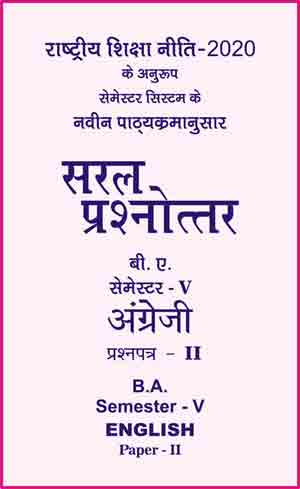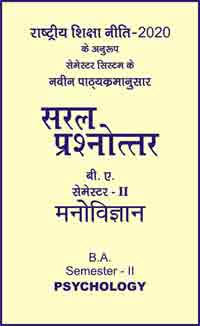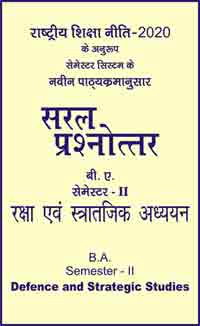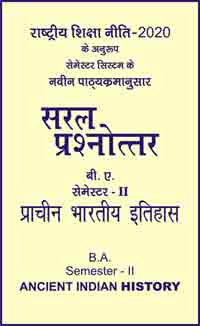|
बी ए - एम ए >> बीए सेमेस्टर-5 पेपर-2 अंग्रेजी बीए सेमेस्टर-5 पेपर-2 अंग्रेजीसरल प्रश्नोत्तर समूह
|
5 पाठक हैं |
|||||||
बीए सेमेस्टर-5 पेपर-2 अंग्रेजी - सरल प्रश्नोत्तर
Question- Critical analysis of the novel The White Tiger written by Aravind Adiga.
Or
Attempt the analysis of the novel The White Tiger written by Aravind Adiga.
Answer-
This novel is an attempt to capture Indianness in a most profound manner, covering substantial as well as the basic flaws that drive the Indian social and cultural system. It, through the frivolous and trivial attitude of the protagonist, Balram Halwai who is later revealed as The White Tiger, tries to bring home the disparities and differences that drives the very so called equally opportunity provided Indian sociopolitical system, that in itself turns out to be a miserable contradiction when we go through the course of the novel.
The book appears appealing and significant to those who take interest in knowing and understanding the makeup of a helpless criminal who commits one mistake to recover the previous one. Adiga has used very colloquial and general English expressions to better transmit the Indian tempo that captures the imagination as well as the attention of the readers who are in pursuit of something Indian in English writings. Adiga was born in Madras in 1974 and was educated at Columbia University and later pursued his interest Magdalen College, Oxford. After completing his formal education Adiga started to try his hand in journalism and his articles begin to appear in The New Yorker, The Sunday Times, The Financial Times and The Times of India. The White Tiger is his first attempt in the field of fiction writing which brought him into limelight as this novel was awarded with Man Booker Prize in 2008. The book is written in the form of letters, where Balram Halwai writes letter to the Chinese Premier Mr.Wen Jiabao discussing the mantras of becoming a successful entrepreneur in India by defying all obstacles.
In fiction we refer these as Epistolary Novel, where writer through different successive letters reveal the course of the novel. The book can be seen as a sociopolitical commentary on the problems that inhabits in almost every part of India. Balram is the protagonist of the novel who remains anonymous up to an age when his school teacher gives him the very name of Balram based on his qualities. Further during the school inspection he was given the title of "White Tiger" because of his extraordinary performance among the ordinary.
Thus, the title of the novel suggests the unique ability of Balram of being intelligent and sharp among other unintelligent and lethargic students, which makes him as rare as a White Tiger. It seems that Adiga has written this book to highlight the issues that Indian society is driven with. Issues such as of Caste system, dowry, corruption, anonymity, economic disparity, class conflict, irrational thinking, traditional dogmas, bribery and the eagerness to become rich by treacherous meAnswer- The novel has been narrated by Balram over eight nights, thus the book is divided into eight parts named after different night. His addressee Mr.Wen Jiabao is a Chinese premier who is expected to arrive in India in future. In the first chapter of the book the First Night, Balram is writing a letter to Wen Jiabao who is currently staying in Beijing. Here Balram appears as a character who is more inclined towards globaliztion and he is trying to bridge his lackings by expanding his business. He starts explaining his success entrepreneurial run, his journey from rag to rich and amid all these he also compares the system, function and form of government that exists in China and India respectively. Balram is a self taught entrepreneur without having a formal education. He time and again points toward the Chandelier to exert a fact now he has become rich despite of such tidy and unprivileged darkness of seamier India he somehow manages to escalate his being into a more professional and advanced with time.
Adiga deliberately divides the Indian people into two types, one having 'big bellies' and the other with 'small'. Balram is a village boy living in an obscure place somehere in Gaya, which he refers as a place filled with 'darkness', he then explains the meaning of darkness which stood as a place where all is available but nothing, people from these darker gloomy spaces have no knowledge of the time, technology, politics or anything that is related to modernity. Rather all of them are succumbed, suppressed and kept alien to. the modern advancement of science and technology. Balram at the very outset confesses to the murder of his master Mr.Ashok and he explains how the money that he theft of him brought a significant change in his life consequently turned him into an entrepreneur of Banglore from a mere rag of darkness. In his early life when he had the opportunity to get school education, he proved himself an intelligent among the rags with ability of giving apt answers to questions that remained unanswered by in the class. After the demise of his father due to TB, he was forced to drop school education and was subjected to aid in his brother's tea shop labour. Adiga outlines the very 'eavesdropping' quality of Indian people, although balram was made alien from the formal education but he kept on learning by hearing over conversation of others. While his stay in Laxmangarh, Balram disassociated himself from others, based on the choice of life. He was not someone who would continue to live the laborious life and tolerate the exploitation from the the leaders whom he calls The Great Socialists' and the landlords. In the second chapter of.the book Adiga vividly portrays the problems of dowry where he, through series of sentences mocked the system ironically: "It was one of the good marriages. We had the boy, and screwed the girl's family hard. I remember exactly what we got in dowry from the girl's side, and thinking about it even now makes my mouth fill up with water: five thousand rupees cash, all crisp newly unsoiled notes fresh from the bank, plus a hero bicycle, plus a thick gold necklace for Kishan."
Balram goes on to narrate his story in a dramatic manner, he creates situations to transmit his story into words and tries keep his addressee intact with him. Adiga used very common Indian expression in Balram's speech. Like when comments on the good, economy of Dhanbad, Adiga uses the expression "Money in the air" which very common to IndiAnswer- Adiga tends to not miss the minute of chances to scorn and criticize the Indian social setup, which he calls trough Balram's voice: "In old days there were one thousand castes and destinies in India. These days, there are just two castes: Men with Big Bellies and Men with Small Bellies and only two destinies: Eat or get Eaten up." Balram shares his experience of sleeping by the side of roads, which is a common in thing in the cities spaces. A journey started from Laxmangarh moves to Dhanbad and then to Delhi and finally in Bangalore. Balram from the very inside was not someone whose thirst of better livelihood would get filled by mere slave jobs, rather he strives forward to become more secure and safe in terms of quality and standard of life. Therefore, throughout the novel we see him eavesdropping others to get new ideas, to learn to unlearn the ill, to develop creative thinking and most importantly the tricks to. bribe that he learned from his master Ashok while staying in Delhi. The novel is written into eight nights, after third night due to sudden disruption of delay in time caused a break, it was 2:44 am in the morning when asked his leave and next he continued on from where he left overnight.
Adiga brings in the element of political discussion where from Balram's voice he gives different interpretation of democracy and often he compares Indian democracy and its pros and cons in respect to China. Balram tells his counterpart about that corruption that remains one of the sought after feature of Indian politics. He introduces the character of The Great social with some special traits that made him distinctive and eligible enough to get the mandate: "You see, a total of ninety three criminal cases - four murder, rape, grand larceny, gun smuggling, pimping, and many other such minor offences are pending against the Great socialist and his ministers".
Despite these flaws and criminal charges, The Great Socialist emerges as the single victorious candidate among the rags from past few decades. Adiga adds many such nourishing elements that aids in making of a criminal which we will later see in case of Balram. Adiga, therefore in process of making a real portrayal of Indian political and governing system, makes many comparisons between the mentioned comparisons. In one of the instance he makes fun of the priorities of Indian politicians: "I gather you yellowskinned men, despite your triumphs in sewage, drinking water, and Olympic gold medals, still don't have democracy. Some politician on the radio was saying that that's we Indians are going to beat you we may not have sewage, drinking water and Olympic gold medals, but we do have democracy".
The very portrayal of society that seems to be very real, makes the novel to be classified as a social realism. During the elections voters are not allowed to vote, or even if allowed then not to vote out of will but by pressure, 'I am India's most faithful voter, and I have not seen the inside of a voting booth'. In the fourth part of the novel, continues the same pattern of starting the conversation discussing the Chandelier and further making a talk of entrepreneurial success. When Balram was hired by one of the Stork of Laxmangarh, he played many tricks before to get the job. Balram as an individual is sketched as an honest, dedicated and laborious person but with passage of time his ambition, goals and motives became contaminated as he a part of that "Rooster Coop" which hardly gives an opportunity to become rich. In the mid of the novel, the another driver of Mr.Ashok's who was named as Ram Prasad revealed to be a muslim by faith, and this revelation caused him his job. Adiga gives an insight on the communal hatred that one holds of another in respect of identity. When Balram was selected as the driver of Honda city and was subjected to along with Ashok and Pinky Madam to Delhi, he prepares himself for the job although he was nervous. Another codriver who shared the drivers room in Delhi with calls him 'country mouse' and tries to malign his thought process and very often leads him to illegitimate sex and illegal things. We see, Adiga using this letter form in a unique way, whenever he breaks the ongoing conversation; he ends it with a note of curiousity and on a dramatic note just like the Indian TV serials. Although this technique may seem altogether a new one for the readers outside subcontinent but familiar within. Balram goes on to call back the past events and finally we are exposed to circumstances under which he was made out to be a criminal. He himself confesses to the Chinese Premier about his crime: "The rest of today's narrative will deal mainly with the sorrowful tale of how I was corrupted from a sweet, innocent village fool into a citified fellow full of debauchery, depravity and wickedness".
In the final chapter of the novel Balram shares his story of transformation from an another rag of a dark village to a well bred entrepreneur who runs taxi services for the call centre employee during late night. Adiga had tried to touch upon almost every possible situation that may come in the process of class movement; Balram's life becomes an epitome of it. Adiga shows how Balram, negotiating all odd and despite of being from a humble background somehow manages to escalate his status, although the journey from a simple villager to a successful entrepreneur was not done overnight but rather by a continuous and consistence ambition of changing social status. Adiga touches upon the issue of forced marriage, Extra marital affairs, relationship with prostitutes for the sake of sex and the concept of material love that happened to be found between Mr.Ashok and Pinky Madam. Using various situations to deliberately put opinion into readers perception is been the highlight of the book that stands unique in itself. The novel is full of Indianness, from the choice of language to the way of expression, it appears Indian in colour. The plot of the novel is not static rather a dynamic, moving from Laxmangarh to Dhanbad to Delhi and finally ends in Bangalore. It's interesting to notice that the mentioned places represent different hierarchy of Economic development, Laxmangarh on one hand is place full of job scarcity and the final one Bangalore is in abundance in job creation.
Thus, by using various places within India, Adiga has tried to bring home the idea of social and economical inequality that mainly dominates the narrative of darker India, where there is no possibility of moving out of caste oppression. This process of social laddering becomes so difficult that one is compelled to commit murder and in avenge lost his family too, only then becomes a successful entrepreneur. The language of the novel is very colloquial and often the Indian expressions are engulfed in them, readers outside Indian subcontinent may find it unusual piece of work where syntax is been experimented upon on regular basis. Adiga has used the Indian way of story telling the narrator creates situation to deliver his speech in an appropriate and effective way although this excitement building process may get noticed after few chapters of the book and may result in disconnection. The novel is more than a simple portrayal of Balram's life, but goes on to serve many other aspects which remains relevant in contemporary times. Sometimes the political comments on bribery and corruption reflects its nature of being a political commentary. There are instances in the book where reader may get disassociated from the course of novel as Adiga doesn't delineate the pat from present, apart from this flaw, the inner depth description of Indian Politics and Economy may sound biased to those who are from well bred governed area. The novel appears as a reflection of subjective understanding of social process which may vary from person to person, but in general it may catch reader's attention. Despite few odds and various merits I you recommend this book worth a reading to get an insight of a villageman's life and transformation, sometimes fighting and more often copping up with the system. Therefore, Balram is a not a person who committed murder abruptly rather he was made to do it as a justification to his social status.
|
|||||
- Question- Discuss in detail the development of English novel from the eighteenth century to the Modern Age.
- Question- What do you understand by Novel? What are the elements which are to considered in plot construction.
- Question- Write a note on characterization of a novel. How much is it important for development of a novel?
- Question- Write a short note on narrative technique of a novel.
- Question- Write a note on the elements of a short story.
- Question- Write a note on Fielding's plot construction.
- Question- Write a note on Fielding's characterisation.
- Question- Define plot. What are the qualities of an ideal plot ?
- Question- Write a short note on the plot construction of a novel.
- Question- What is the difference between Flat Character and Round Character?
- Question- Write a short note on the characterization of a novel.
- Question- Write a short note on narrative technique of a novel.
- Question- What is a short story? What is the difference between a short story and a novel?
- Question- What is a picaresque novel? Who are the main exponents of the picaresque novel?
- Question- What is a historical novel? What is the difference between history and a historical novel? Name a few historical novelists and their creation.
- Question- What do you know about the Gothic novel?
- Question- Write a note on Epistolary novel.
- Question- Write a note on the Regional novel.
- Question- Point out the chief characteristics of the Picaresque novel.
- Question- Point out the chief characteristics of the historical novel.
- Question- Write an essay on Sir Walter Scott's contribution to historical novel.
- Question- Point out the chief characteristics of Gothic novel.
- Question- Point out the chief characteristics of the Regional novel.
- Question- What is a regional novel? Name a few novelists of this genre and their novels.
- Question- What is a Picaresque novel?
- Question- What do you know about Historical novel?
- Question- What do you know about Gothic novel?
- Question- Examine the merits of Sir Walter Scott as a Historical novelist.
- Question- What do you mean by domestic novel?
- Question- What do you mean by the Stream of consciousness? Who. coined the term?
- Question- What is a Epistolary novel?
- Question- What do you know about the Regional novel?
- Question- Trends in 20th and 21st Century Fiction Discuss as a sub-genre of crime fiction and mystery.
- Question- Define utopian fiction. Discuss its history and origin.
- Question- What is campus novel? Explain its history and development.
- Question- Write a note on Detective novel.
- Question- Write a note on Science fictions.
- Question- Write a note on Meta fiction.
- Question- Define mythology. Explain the rise of mythological fiction in India.
- Question- What is space fiction? Discuss its characteristics and example.
- Question- Define chick lit. Discuss its characteristics and example.
- Question- Define junk fiction. Explain its characteristics and types of junk fiction.
- Question- Write a short note on detective novel.
- Question- Write short note on Science fiction.
- Question- What is Meta fiction?
- Question- What is Science Fiction?
- Question- What is utopian fiction?
- Question- Why are campus novels important? What kind of characters are in campus novels?
- Question- What is dystopian fiction?
- Question- Discuss feminism in mythological fiction.
- Question- Why are campus novels important? What kind of characters are in campus novels?
- Question- What is chic lit fiction?
- Question- Write a note on the life and works of Charles Dickens.
- Question- Write a note on Charles Dickens as a novelist.
- Question- Write a note on the development of English novel up to Dickens.
- Question- Write a note on Dicken's social criticism. What was Dickens' attitude toward various social evils of the day?
- Question- Describe Dickens as a representative of his age.
- Question- Write a note on Dickens as a social reformer.
- Question- Write a note on the social background of Dickens.
- Question- Write a note on Dickens's contribution to English novel.
- Question- Discuss symbolism as a structural elements in A Tale of two cities.
- Question- Discuss Dickens's art of characterization in the novel "A Tale of Two Cities".
- Question- What is meant by criticism of life? What is the 'vision of life"? Point out the criticism and vision of life in A Tale of Two Cities.
- Question- Write a note on the blend of realism and idealism in the novels of Dickens.
- Question- "Dickens' characters are both types and individuals.” Discuss.
- Question- Write a note on Dickens as a satirist.
- Question- What is the significance of the name "Jacques" in A Tale of Two Cities?
- Question- In Book 2, Chapter 21 of A Tale of Two Cities, what is happening in France that upsets Mr. Jarvis Lorry?
- Question- Write the life of Thomas Hardy and about his career.
- Question- What are the three phases of Hardy's writing? What were the issues he dealt with in those three phases?
- Question- Write short notes on the major characters of the novel, and show how Hardy develops these characters in the course of the novel.
- Question- Who is the heroine of 'Far From the Madding Crowd"? How doy o you justify her position as the heroine?
- Question- Explain the tragic vision of Hardy in Far From the Mad ding Crowd.
- Question- Why does Bathsheba reject Gabriel's proposal at the start of the novel?
- Question- How is sexual desire portrayed in the novel?
- Question- How was Oak's life saved by Bathsheba?
- Question- How was Oak completely ruined?
- Question- Describe the feast after sheep-shearing.
- Question- How are Oak and Bathsheba ultimately a happy couple?
- Question- Discuss Jane Austen as a realist.
- Question- Point out Jane Austen's contribution to the English novel.
- Question- Write a note on characterisation of Jane Austen with special reference to 'Pride and Prejudice'.
- Question- Is there artistic detachment in Jane Austen ? Write a brief note in support to your view with illustrations.
- Question- Sketch the character of Fitzwilliam Darcy.
- Question- Sketch the character of George Wickham.
- Question- Do you agree with the view that the novel 'Pride and Prejudice' revolves around two themes of 'Pride and Prejudice'? Give reasons for your answer?
- Question- Write an essay on the sequence of events in 'Pride and Prejudice'?
- Question- Write a note on Life Sketch of George Eliot Life Sketch of George Eliot
- Question- Discuss the humour elements in George Eliot's The Mill on the Floss.
- Question- Critically examine the artistic and the philosophic dimensions of the ending of The Mill on the Floss in the light of the view of the individual and society presented in the novel.
- Question- Compare and contrast Maggie's love for Philip, Stephen, and Tom.
- Question- Describe the thematic import of Maggie's decision to relinquish Stephen.
- Question- Compare and contrast Tom and Maggie. How much are their respective successes and failures a function of gender and how much a function of their distinct characteristics?
- Question- Compare and contrast Tom and Mr. Tulliver. Why does Tom succeed where Mr. Tulliver failed?
- Question- Write a note on life kketch of Toni Morrison.
- Question- Discuss the narrative strategies used by the writer in The Bluest Eye.
- Question- Discuss the narrative structure of the novel. Why might Morrison have chosen to present the events in a non- chronological way?
- Question- What does the title of The Bluest Eye mean?
- Question- How are Pecola Breedlove and Maureen Peal foils to one another?
- Question- The Bluest Eye uses multiple narrators, including Claudia as a child, Claudia as an adult, and an omniscient narrator. Which narrative point of view doyou think is most central to the novel and why?
- Question- Who do you think is the most sympathetic character in the novel and why?
- Question- The Bluest Eye is a novel about racism, and yet there are relatively few instances of the direct oppression of black people by white people in the book. Explain how racism functions in the story.
- Question- Write a note on Life Sketch of The Harper Lee.
- Question- Analyze the childhood world of Jem, Scout, and Dill and their relationship with Boo Radley in Part One.
- Question- What is Atticus's relationship to the rest of Maycomb? What is his role in the community?
- Question- Discuss the role of family in To Kill a Mockingbird, paying close attention to Aunt Alexandra.
- Question- Discuss the author's descriptions of Maycomb. What is the town's role in the novel? Analyze the author's treatment of Boo Radley. What is his role in the novel?
- Question- Discuss Atticus's parenting style. What is his relationship to his children like? How does he seek to instill conscience in them?
- Question- Identify Atticus Finch, Jean Louise (Scout) Finch, Jem Finch, Maycomb, Calpurnia, Charles Baker (Dill) Harris, The Radley Place, Stephanie Crawford, Arthur (Boo) Radley, Miss Caroline Fisher, Walter Cunningham, and Burris Ewell.
- Question- Why did Mr. Cunningham's mob leave?
- Question- In Chapter 2 of To Kill a Mockingbird what does Miss Caroline, Scout's first-grade teacher, represent?
- Question- In Chapter 6 of To Kill a Mockingbird why is Jem is determined to retrieve his pants from the fence despite the danger of meeting up with Nathan Radley?
- Question- What is the significance of the title To Kill a Mockingbird according to Atticus's reasoning in Chapter 10?
- Question - Comment upon the role of the lions in The Old Man And The Sea.
- Question- Comment upon the symbolic role played by Di Maggio in the novel "The Old Man And The Sea'...
- Question- Comment upon the arm-wrestling episode in the novel 'The Old Man and The Sea'.
- Question- Comment upon the marlin separating episode in the novel "The Old Man and The Sea".
- Question- Write a note on the major themes of the novel The Old Man and The Sea'.
- Question- Write a brief note on The Old Man And The Sea' as a tragedy.
- Question- Which claims your attention more in The Old Man And The Sea' its narrative or allegory?
- Question- The hero of the novel "The Old Man And The Sea' is really a Christfigure. Comment.
- Question- Write a brief note on Hemingway hero or the autobiographical hero.
- Question- In the fight of the old man against the giant fish what we see is a "battle of attrition". Comment.
- Question- Write a note on Life Sketh of John Ernst Steinbeck.
- Question- Analyze Tom Joad's growth throughout the novel. Despite the fact that Tom is not a young boy, does the novel have the characteristics of a bildungsroman, or coming-of-age story?
- Question- Discuss the development of Tom Joad as a character. How does he grow throughout the book? What effects do Jim Casy's imprisonment and death have on his development?
- Question-What themes related to family are in The Grapes of Wrath?
- Question- How does the erosion described in Chapter 1 of The Grapes of Wrath relate to the Bank monster described in Chapter 5?
- Question- How do the roles of Ma and Pa differ in the Joad family in The Grapes of Wrath?
- Question- In The Grapes of Wrath how is the Gila monster described in Chapter 13 comparable the Bank monster?
- Question- What biblical allusions does John Steinbeck include in The Grapes of Wrath and how does he use them?
- Question- How do the roles of Ma Joad and Pa Joad within the family change in The Grapes of Wrath?
- Question- In The Grapes of Wrath, why does the Joad family deteriorate after the Joads leave Oklahoma?
- Question- Write a note on Life Sketch of Aravind Adiga
- Question- Discuss plot of the novel The White Tiger.
- Question- Explain literary analysis of The White Tiger by Aravind Adiga.
- Question- Critical analysis of the novel The White Tiger written by Aravind Adiga.
- Question- What is Balram's attitude toward religion? How does this develop throughout the novel?
- Question- How does this portrayal of India differ from more typical literary depictions of India?
- Question- Why does Balram choose to address his narrative to the Premier of China? How would the story have been different without this framing device?
- Question- Discuss Balram's many names throughout the novel, and how each one represents an aspect of him.
- Question- What does Balram's experience in Bangalore reveal about the Indian economy in an increasingly globalized world?
- Question- Attempt critical analysis of the novel 'Dalits, Dynasty and She' by Sanjay Chitranshi.
- Question- Explain the plot of the novel 'Dalits, Dynasty and She 'written by Sanjay Chitranshi.
- Question- Discuss the Novel 'Dalits, Dynasty and She' by Sanjay Chitranshi.
- Question- Who was Shanti Devi?
- Question- Write a' character sketch of Ram Chandra.
- Question- Write a note on Life Sketch of Sudha Murty.
- Question- What are the major themes of the novel "Dollar Bahu"?
- Question- Discuss how the notion of self sacrifice is exclusively attributed to a particular gender in Indian society. How they thrive through the difficult situation in life when they are implanted to a new atmosphere.
- Question- Write a note on the title "Dollar Bahu?".
- Question- Write a note on the end of the novel "Dollar Bahu".
- Question- Discuss the central theme of Dollar Bahu.














